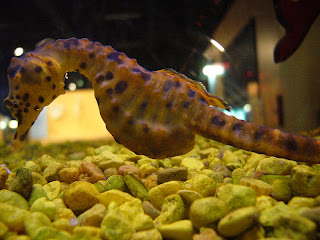 |
| Hippocampus abdominalis |
This species, which is found in the shallow waters off of Australia and New Zealand, can grow to be 14in long! They are one of the largest Seahorse species on the planet.
Big-belly Seahorses get their common name from the large size of their abdomen. It protrudes on both males and females, though the males have an extra pouch for incubating the young. Yes, male Seahorses care for the babies! The female will lay her eggs in his pouch, and he will swim around with them until they hatch. He can carry hundreds of eggs at a time!
Big-belly Seahorses spend most of their time near seaweed, coiling their tails around the plants to stay in place. They feed by sucking in tiny crustaceans through their long snouts. They swallow their prey whole.
To keep from becoming prey themselves, the Big-belly Seahorses attempt to camouflage themselves in with the seaweed. They also have eyes that move independently from one another, so they can watch for danger.
IUCN Status : Data Deficient
Location : Australia, New Zealand
Size : Body length up to 14in (35cm)
Classification : Phylum : Chordata -- Class : Actinopterygii -- Order : Syngnathiformes
Family : Syngnathidae -- Genus : Hippocampus -- Species : H. abdominalis
Image : Drow Male
Family : Syngnathidae -- Genus : Hippocampus -- Species : H. abdominalis
Comments
Post a Comment